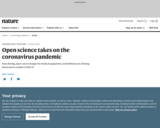
Data sharing, open-source designs for medical equipment, and hobbyists are all being harnessed to combat COVID-19.
- Subject:
- Life Science
- Material Type:
- Reading
- Author:
- Mark Zastrow
- Date Added:
- 08/11/2021

Data sharing, open-source designs for medical equipment, and hobbyists are all being harnessed to combat COVID-19.

Keynote presentations, workshop materials, and other helpful resources from the 2020 Partnerships for Well-Being Institute hosted by Human Services at UC Davis Continuing and Professional Education. This includes content from both the June 3 Virtual Mini-Institute and the in-person institute currently scheduled for Dec. 8-10 in Garden Grove, CA.

This resource is a video abstract of a research paper created by Research Square on behalf of its authors. It provides a synopsis that's easy to understand, and can be used to introduce the topics it covers to students, researchers, and the general public. The video's transcript is also provided in full, with a portion provided below for preview:
"COVID-19, caused by the virus SARS-CoV-2, is a significant challenge to health systems worldwide. Its severity appears to be most likely caused by acute inflammation and widespread intravascular coagulation. A recent review examines the molecular basis underlying coagulation and inflammation in COVID-19. Phosphatidylserine (PtdSer) typically lies in the inner leaflet of the plasma membrane in healthy cells. Under some physiological conditions, PtdSer exposure on the outer leaflet of platelets promotes coagulation factor aggregation. However, in pathophysiological conditions, PtdSer exposure may cause excessive activation of coagulation and in viral infections, this may increase infectivity and viral spread. Evidence suggests that SARS-CoV-2 exposure may upregulate PtdSer on cell surfaces throughout the body. causing disseminated coagulation throughout the body. In addition, the virus may upregulate the activity of the protein ADAM-17, which has roles in protecting the heart but can also promote inflammation..."
The rest of the transcript, along with a link to the research itself, is available on the resource itself.

So much has changed since March 2020 when campuses closed. Keeping the doors of learning open we found ways forward and continued to do our learning from home. The world is a different place and being on campus is different too. As you know, campuses are opening in a limited way for 2020-2021 academic year. This short course provides information for ALL students to keep yourself and others safe as a select few go back to campus.Certain links in our module may take you to other websites: We provided these links only as a convenience, and not as an endorsement of any linked site or the information, products or services appearing thereon. These links and sites are not under the control of the creators of this module. If you decide to visit any of these sites, you do so at your own risk. We are not responsible for the content of any such linked sites or any other web page that is not part of our site. Accordingly, you agree that the we will not be responsible or liable in any way for the accuracy, legality, relevancy, decency or copyright compliance of material and information contained in any site linked from this module.
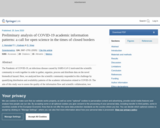
The Pandemic of COVID-19, an infectious disease caused by SARS-CoV-2 motivated the scientific community to work together in order to gather, organize, process and distribute data on the novel biomedical hazard. Here, we analyzed how the scientific community responded to this challenge by quantifying distribution and availability patterns of the academic information related to COVID-19. The aim of this study was to assess the quality of the information flow and scientific collaboration, two factors we believe to be critical for finding new solutions for the ongoing pandemic. The RISmed R package, and a custom Python script were used to fetch metadata on articles indexed in PubMed and published on Rxiv preprint server. Scopus was manually searched and the metadata was exported in BibTex file. Publication rate and publication status, affiliation and author count per article, and submission-to-publication time were analysed in R. Biblioshiny application was used to create a world collaboration map. Preliminary data suggest that COVID-19 pandemic resulted in generation of a large amount of scientific data, and demonstrates potential problems regarding the information velocity, availability, and scientific collaboration in the early stages of the pandemic. More specifically, the results indicate precarious overload of the standard publication systems, significant problems with data availability and apparent deficient collaboration. In conclusion, we believe the scientific community could have used the data more efficiently in order to create proper foundations for finding new solutions for the COVID-19 pandemic. Moreover, we believe we can learn from this on the go and adopt open science principles and a more mindful approach to COVID-19-related data to accelerate the discovery of more efficient solutions. We take this opportunity to invite our colleagues to contribute to this global scientific collaboration by publishing their findings with maximal transparency.

This resource is a video abstract of a research paper created by Research Square on behalf of its authors. It provides a synopsis that's easy to understand, and can be used to introduce the topics it covers to students, researchers, and the general public. The video's transcript is also provided in full, with a portion provided below for preview:
"With the COVID-19 pandemic causing a global health crisis, accurate diagnosis is critical. Diagnosing acute disease relies on RT-PCR tests measuring the presence of SARS-CoV-2 in the sampled material but in patients with suspected COVID-19 with a negative RT-PCR result, measuring anti-viral antibodies can help clinicians identify infected individuals. Antibody testing can also determine if someone was previously infected and help to measure the prevalence of the virus in a community. A new study characterizes an assay measuring total antibodies – combined IgA, IgM, and IgG isotypes – against SARS-CoV-2. The assay, ECLIA, specifically measures antibodies against the S1 subunit of the viral spike, which carries the virus’s receptor binding domain. Researchers in Liechtenstein evaluated ECLIA in a population with 125 cases of confirmed SARS-CoV-2 infection and 1159 individuals without evidence of COVID-19. The results showed a test sensitivity of 97.6%, while the specificity was 99.8%..."
The rest of the transcript, along with a link to the research itself, is available on the resource itself.

This resource is a video abstract of a research paper created by Research Square on behalf of its authors. It provides a synopsis that's easy to understand, and can be used to introduce the topics it covers to students, researchers, and the general public. The video's transcript is also provided in full, with a portion provided below for preview:
"With the global health crisis of COVID-19 having widespread effects on economies and communities, understanding environmental factors that affect the transmissibility of SARS-CoV-2 is critical. Following up on a previous study demonstrating that removing shoes indoors may lower the COVID-19 mortality rate, researchers in Japan evaluated the correlation of a unique metric with COVID-19 morbidity and mortality. Tatami is a type of straw mat used for flooring in traditional Japanese-style rooms. Because people customarily remove their shoes before entering tatami rooms researchers used the density of tatami stores in a locale as a proxy for the cultural practice of shoe removal. They found that while COVID-19 morbidity and mortality increased with population density there was a negative correlation between the number of tatami stores per 100,000 people – and therefore the likelihood of shoe removal – and the number of COVID-19 cases ..."
The rest of the transcript, along with a link to the research itself, is available on the resource itself.

This document highlights privacy and equity considerations that emerge when students are required by districts to use video in online classrooms and explores alternative ways to measure student engagement that account for these concerns.
Future of Privacy website is available under a Creative Commons Attribution License : https://fpf.org/privacy-policy
Image by Alexandra_Koch from Pixabay

This resource is a video abstract of a research paper created by Research Square on behalf of its authors. It provides a synopsis that's easy to understand, and can be used to introduce the topics it covers to students, researchers, and the general public. The video's transcript is also provided in full, with a portion provided below for preview:
"The recent outbreak of SARS-CoV-2 infections has strained healthcare systems worldwide and diagnostic testing is a critical part of any pandemic management plan. PCR tests on clinical samples collected by health care professionals (HCPs) is currently the gold standard, but patient self-sampling may facilitate increased testing without adding strain or risk of exposure for HCPs. A recent study tested the sensitivity, feasibility, and acceptance of self-collected oropharyngeal samples. Hospitalized SARS-CoV-2-infected patients collected two self-administered samples and filled out a questionnaire. Researchers also collected HCP-administered samples for comparison. While the HCP-collected samples had the highest estimated sensitivity compared to each of the self-collected samples, at 88%, 78%, and 77% respectively, using both self-collected sample results together increased their estimated sensitivity to 88%, which is comparable to the HCP-collected samples..."
The rest of the transcript, along with a link to the research itself, is available on the resource itself.

This resource is a video abstract of a research paper created by Research Square on behalf of its authors. It provides a synopsis that's easy to understand, and can be used to introduce the topics it covers to students, researchers, and the general public. The video's transcript is also provided in full, with a portion provided below for preview:
"The COVID-19 pandemic, caused by the virus SARS-CoV-2, has spread rapidly since 2019. COVID-19 symptoms are mild in some patients but severe and even life-threatening in others and there are still no reliable treatments for severe COVID-19. In a recent study, researchers investigated the factors related to COVID-19 severity in hospitalized patients with mild or severe illness. Specifically, they investigated the patients’ immune characteristics and signaling pathways involving immune proteins called IFN-Is. Compared with healthy controls, patients with COVID-19 had lower counts of many types of immune cells but higher counts of Th17 cells in their blood and the differences were more drastic in patients with severe disease. In addition, individuals with severe COVID-19 had much lower levels of IFN-I signaling molecules than healthy controls..."
The rest of the transcript, along with a link to the research itself, is available on the resource itself.

This resource is a video abstract of a research paper created by Research Square on behalf of its authors. It provides a synopsis that's easy to understand, and can be used to introduce the topics it covers to students, researchers, and the general public. The video's transcript is also provided in full, with a portion provided below for preview:
"The COVID-19 outbreak is a devastating ongoing pandemic. Most patients experience mild symptoms, but some develop severe disease. An even smaller subset of patients develop acute respiratory distress syndrome, which has high mortality. To unravel the molecular mechanisms at play, researchers retroactively examined clinical records from patients with confirmed COVID-19. They found that severe cases had increased levels of inflammatory damage markers and lower T cell numbers – including total T cells, CD4+, and CD8+ T cells – than moderate cases. Analysis of public single-cell RNA-seq data revealed severe cases had increased clonal expansion of macrophages and highlighted that high-TREM2-expressing macrophages were dramatically enriched in moderate cases of COVID-19. Cell communication analysis suggested that high-TREM2 macrophages drive ligand-receptor cross talk, which may contribute to the exhaustion of CD8+ cells..."
The rest of the transcript, along with a link to the research itself, is available on the resource itself.

This resource is a video abstract of a research paper created by Research Square on behalf of its authors. It provides a synopsis that's easy to understand, and can be used to introduce the topics it covers to students, researchers, and the general public. The video's transcript is also provided in full, with a portion provided below for preview:
"The COVID -19 pandemic has swept the globe. It is now evident that severe COVID-19 cases are associated with hyper-activation of the immune system, known as the “cytokine storm”. One of the central molecules involved in a cytokine storm is interleukin-6 (or IL-6). At normal levels, IL-6 helps fight infection but when in excess, IL-6 can help trigger a cytokine storm. Some bacterial species are known to directly or indirectly affect IL-6 signaling and thus help contribute to the creation of cytokine storms. Researchers have hypothesized that these bacterial species could also contribute to the cytokine storm in COVID-19. They propose a mechanism through which these bacterial species can contribute to the development of the COVID-19 cytokine storm. If their hypothesis is confirmed, it could mean that antibiotic treatment before or at an early stage of infection could reduce the chance of later developing a cytokine storm and help reduce the number of life-threatening cases of COVID-19..."
The rest of the transcript, along with a link to the research itself, is available on the resource itself.
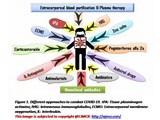
ABSTRACTCorona pandemic has unfurled its wings to disrupt the healthcare system of developing as well as developed countries and created havoc among healthcare professionals. Today, there is an atmosphere of trepidation at the possibility of getting new cure against this dreadful virus. People are looking with anxious eyes toward scientists to develop a vaccine against this virus. Already killed thousands of lives, this virus is spreading at a pace of fire. Some healthcare professionals and researchers are working out of the way to develop a new vaccine, and some are targeting the existing drug approach. Several successful trials were performed on Coronavirus disease-2019 (COVID-19) patients involving existing drugs in combination till date. This case series underlined those successful case studies of COVID-19. Different combinational approaches have been adopted by researchers such as the use of tissue plasminogen activators, extracorporeal membrane oxygenation and convalescent plasma therapy, intravenous immunoglobulins, antivirals drugs, antimalarials, antibiotics, interleukin antagonists, and corticosteroids to combat COVID-19. These therapies have corroborated to be constructive at some levels among individuals having a severe medical history as well as individuals without any profound medical history

This course explores the importance of public transportation to social and economic recovery from the COVID-19 pandemic and seeks to identify approaches to restoring transit ridership, with a focus on Metro Boston. We will attempt to (1) understand whether and how the COVID-19 pandemic can advance sustainable mobility, and specifically the role(s) of public transportation in the COVID-19 recovery process, and (2) identify policies and/or interventions that may encourage pre-COVID transit riders to return to transit and attract net new transit ridership.
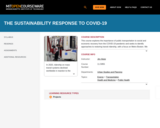
This course explores the importance of public transportation to social and economic recovery from the COVID-19 pandemic and seeks to identify approaches to restoring transit ridership, with a focus on Metro Boston. We will attempt to (1) understand whether and how the COVID-19 pandemic can advance sustainable mobility, and specifically the role(s) of public transportation in the COVID-19 recovery process, and (2) identify policies and/or interventions that may encourage pre-COVID transit riders to return to transit and attract net new transit ridership.
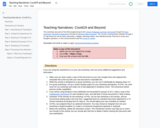
This workshop was part of Fall 2020 programming for the Cluster Pedagogy Learning Community through the Open Learning & Teaching Collaborative (CoLab) at Plymouth State University. The CoLab is sharing these materials through a CC-By license for use by other universities, colleges, teaching centers, and individual faculty. Feel free to share your thoughts, questions, or own version/revision with the CoLab on Twitter.

This resource is a video abstract of a research paper created by Research Square on behalf of its authors. It provides a synopsis that's easy to understand, and can be used to introduce the topics it covers to students, researchers, and the general public. The video's transcript is also provided in full, with a portion provided below for preview:
"COVID-19, caused by the enveloped RNA virus SARS-CoV-2, primarily affects the respiratory and gastrointestinal systems. Disease severity varies substantially across patients; the disease is mild or asymptomatic in some cases and causes respiratory failure or death in others. SARS-CoV-2 viral RNA has been detected in fecal samples, suggesting that the gastrointestinal tract may be a site of viral replication. To better understand the effect of SARS-CoV-2 on resident gut viruses (the “gut virome”), researchers examined blood samples and fecal specimens from 98 patients with COVID-19 and 78 healthy individuals. Using shotgun metagenomics, they found that patients with COVID-19 had decreased abundance of certain RNA viruses and DNA-based bacteriophages. In contrast, environment-derived eukaryotic DNA viruses were enriched in COVID-19 patients..."
The rest of the transcript, along with a link to the research itself, is available on the resource itself.

In our resource, we highlight the role of the viral non-structural proteins and their role in blocking host interferon signaling of the innate immune system. In addition, we also describe the host immune response specifically the cytokine signaling clouds in the variation in severity of patients living with COVID-19. Finally, we apply these latest peer-reviewed research on host immune response to SARS-CoV-2 in the context of integrated immunology framework linked with three-dimensional learning in life science education and topics on social justice dimensions of vaccination access in global health. Through the social justice lens and global health perspectives, we provide an innovative framework to engage undergraduates in the field of integrated immunology and developmental biology in both remote and hybrid-flexible (HyFlex) learning settings.

What exactly is a vaccine? Can vaccines prevent outbreaks? How effective does a vaccine need to be to help a population during an outbreak? Students will explore these questions and more in this lesson plan by first learning the biology behind vaccines. They will then use Science Buddies' SimPandemic, a free online tool, to model different vaccine parameters to understand how vaccines affect both individuals and populations during a COVID-19 outbreak. Remote learning adaptation: This lesson plan can be conducted remotely. Students can work independently on the Explore section of the lesson plan using the Student Worksheet as a guide. The Engage and Reflect sections can either be dropped entirely, done in writing remotely, or be conducted over a video chat.
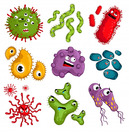
This I.L.P. It aims to teach the concept of some viral diseases, the symptoms, the place of origin and the risks of each of them so that, adolescents are more informed about the subject, can speak properly and know how to differentiate if they have any symptoms. Also, it will help them to have more knowledge about the different viruses that have affected the world.